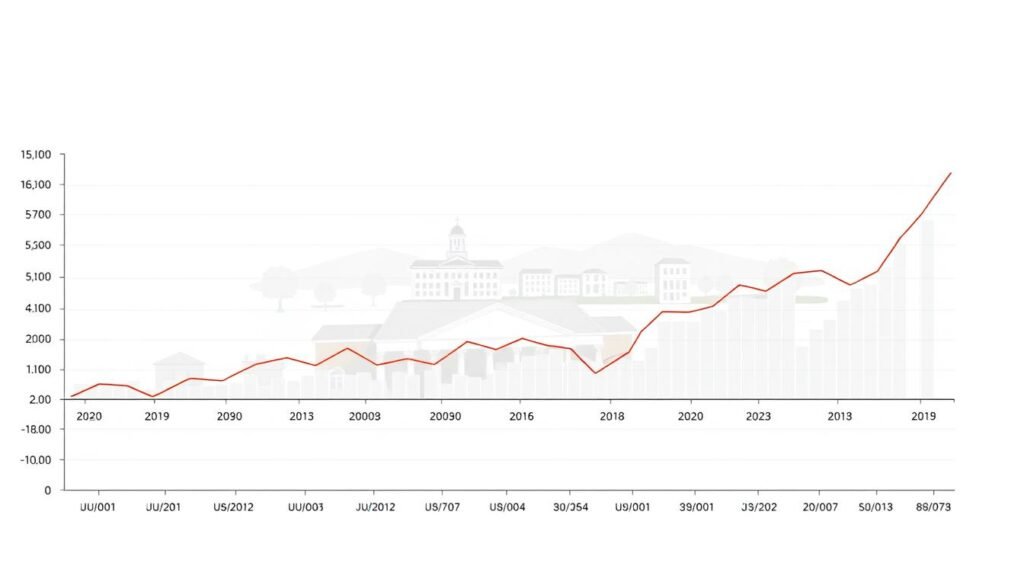Did you know that students now shoulder 64% of educational costs compared to just 42% in the late 1990s? This shift highlights the growing financial burden on those pursuing degrees. Understanding the landscape of higher education funding is crucial for students and families navigating the rising costs of tuition.
Virginia’s public institutions, for example, rank second nationally in graduation rates. Yet, they also have the fifth-highest net costs in the country. This paradox raises questions about how funding mechanisms impact accessibility and equity in education.
Over the past two decades, state funding per student has declined by 33%, while tuition has risen significantly. This trend has led to a growing student debt crisis, making it harder for many to afford college. Exploring the types of funding available and their eligibility requirements can help students find the support they need.
Key Takeaways
- Students now fund 64% of educational costs, up from 42% in 1998.
- Virginia’s public institutions have high graduation rates but also high net costs.
- State funding per student has declined by 33% since the late 1990s.
- Tuition costs have risen significantly, contributing to the student debt crisis.
- Understanding funding types and eligibility is essential for financial planning.
Overview of Higher Education Funding in the US
The financial landscape of colleges and universities has shifted dramatically over the decades. State support for these institutions has declined, while tuition and fees have risen significantly. This change has placed a heavier burden on students and their families.
In the past, state funding covered a larger portion of costs. For example, Virginia’s state support per student is $4,800, compared to the national average of $6,400. This gap highlights the challenges faced by public colleges in maintaining affordability.
Historical Context of Higher Education Funding
From the late 20th century to today, funding models have evolved. State contributions have decreased, while non-academic fees have grown. Mandatory fees, such as those for athletics and facilities, now average $3,502 per student.
Virginia’s capital project spending is $2,782 per student, nearly double the national average. However, this has led to a $1.4 billion deferred maintenance backlog, affecting campus infrastructure.
Current State of Higher Education Funding
Today, universities rely more on generated revenue and fees. Athletic budgets, for instance, are 31% self-funded. Non-academic fees beyond athletics and debt service add $1,745 per student annually.
Funding goals also vary widely. While some institutions achieve 77% of their targets, others struggle at 40%. This disparity underscores the need for equitable funding solutions.
Types of Higher Education Funding
Students today face a variety of funding options to support their academic journey. These sources include federal, state, institutional, and private programs. Each type has unique features and eligibility criteria, making it essential to understand their differences.
Federal Funding Programs
Federal aid is a primary source of support for many students. Programs like Pell Grants and federal loans help cover tuition and living expenses. These funds are often need-based, ensuring access for those with financial challenges.
State Funding Programs
State programs vary widely across the country. For example, Virginia’s TAG program allocates 33% of state aid to private school students, regardless of need. Additionally, Virginia has tuition reciprocity agreements with neighboring states, expanding opportunities for residents.
Institutional and Private Funding
Colleges and universities also provide their own aid. For instance, UVA’s $14.5 billion endowment allows for generous scholarships, while Norfolk State’s $58 million fund limits its offerings. Private funding, including corporate partnerships and foundation-managed grants, further supplements these resources.
Corporate tax incentives often encourage businesses to fund scholarship programs. This collaboration between institutions and the private sector helps bridge financial gaps for students.
Eligibility Requirements for Higher Education Funding
Navigating the maze of financial aid options can be overwhelming for students and families. Each program has its own set of criteria, making it essential to understand the eligibility requirements. Whether it’s federal aid, state grants, or private scholarships, knowing the rules can help secure the support needed.
Federal and State Aid Eligibility
Federal aid programs like Pell Grants and Stafford Loans are need-based. Students must complete the FAFSA to determine their eligibility. Factors like family income, household size, and enrollment status play a key role.
State aid varies widely. For example, Virginia’s TAG program allocates 33% of its funds to private school students, regardless of need. Some states also offer tuition reciprocity agreements, expanding opportunities for residents.
Institutional Scholarships and Grants
Colleges and universities often provide their own financial aid. These awards may be based on merit, need, or specific criteria like leadership or community service. For instance, UVA’s $14.5 billion endowment allows for generous scholarships, while smaller institutions may have limited funds.
It’s important to check each school’s deadlines and requirements. Some programs may require additional essays or interviews.
Private Scholarships and Loans
Private scholarships are offered by organizations, businesses, and foundations. These awards often have unique criteria, such as field of study or demographic background. Students should use reputable search platforms to find opportunities.
Private loans are another option, but they come with higher interest rates and stricter terms. In Virginia, private loans account for 7.8% of student debt. Comparing lenders like Sallie Mae and credit unions can help find the best rates.
Cosigner release policies and origination fees vary by lender, so it’s crucial to read the fine print. Additionally, 529 plans offer tax-advantaged savings for future education costs, with contribution limits and tax implications to consider.
Trends in Higher Education Funding
Over the past two decades, the financial burden on students has grown significantly due to rising costs and shifting funding models. Net tuition revenue has increased by $4,177 per student since 1998, reflecting a dramatic change in how education is financed.
In Virginia, non-E&G fees average $3,502 per student, compared to the national average of $2,100. This disparity highlights the varying levels of financial pressure faced by students across different states.
Impact of Economic Downturns on Funding
Economic downturns have significantly affected funding for colleges and universities. During recessions, state budgets often shrink, leading to reduced support for public institutions. This forces schools to rely more on tuition and fees to cover operational costs.
For example, the 2008 financial crisis led to a sharp decline in state funding, which has yet to fully recover. This trend has left many institutions struggling to balance budgets while keeping costs affordable for students.
Shifts in Funding Allocation Models
Funding allocation models have evolved in response to financial challenges. Many private colleges have adopted tuition reset strategies to attract more applicants. These strategies involve lowering sticker prices while increasing financial aid packages.
Income share agreements (ISAs) are also gaining traction. ISAs allow students to pay a percentage of their future income instead of upfront tuition. This model is particularly popular in sectors like technology and healthcare.
Rising Tuition Costs and Student Debt
Rising tuition costs have contributed to a growing student debt crisis. For-profit institutions, in particular, have a 22% cohort default rate, significantly higher than public and nonprofit schools.
Reverse transfer credit programs are emerging as a solution to reduce debt accumulation. These programs allow students to earn associate degrees while pursuing bachelor’s degrees, making their education more affordable and efficient.
Performance-Based Funding Models
Performance-based funding models are reshaping how resources are allocated in academia. These systems tie financial support to specific outcomes, such as graduation rates or student success metrics. This approach aims to incentivize institutions to focus on results rather than just enrollment numbers.
Overview of Performance-Based Funding
Performance-based funding rewards colleges and universities for achieving key milestones. For example, 70% of four-year systems now include race metrics to promote equity. States like Arizona have implemented weighted funding for Pell Grant recipients, ensuring access for low-income students.
This model also considers completion milestones for part-time students and success points for adult basic education transitions. Rural service areas often receive additional supplements to address unique challenges.
Impact on Institutional Behavior
Institutions are adapting their strategies to meet performance targets. For instance, many are enhancing support services for first-generation students, with some states offering 2:1 funding matches for these initiatives. This shift encourages schools to prioritize student success over sheer enrollment numbers.
However, critics argue that this approach may pressure schools to focus on short-term gains rather than long-term educational quality.
Equity Considerations in Performance-Based Funding
While performance-based funding aims to promote equity, it can inadvertently disadvantage underfunded institutions. Schools serving marginalized communities may struggle to meet high benchmarks without adequate resources.
To address this, some states are equalizing funding for community college districts and incorporating metrics that reflect diverse student populations. These adjustments ensure that the model supports all students fairly.
Federal Emergency Funding During COVID-19
The COVID-19 pandemic brought unprecedented challenges to campuses nationwide, prompting swift federal action to support students and institutions. Over $39 billion was allocated through three major relief packages: the CARES Act, CRRSAA, and ARP. These funds prioritized needy students and helped colleges adapt to the crisis.
CARES Act (HEERF I)
The CARES Act, passed in March 2020, provided $14 billion in emergency funding. Students received direct grants averaging $1,000 to $3,500, based on financial need. Institutions also used funds for mental health services and campus safety measures.
This legislation ensured that schools could maintain operations while addressing the immediate needs of their communities.
CRRSAA (HEERF II)
The CRRSAA, enacted in December 2020, added $23 billion to the relief effort. It expanded access to grants for students and allowed institutions to cover COVID-19 testing infrastructure costs. Public health compliance audits were also funded to ensure safety protocols were met.
This phase emphasized long-term solutions to keep campuses safe and functional.
ARP (HEERF III)
The ARP, signed in March 2021, allocated an additional $40 billion. It extended carryover allowances into FY2023, giving institutions more flexibility. Funds were also used to address learning loss and improve remote education tools.
This final package aimed to stabilize colleges and universities while preparing for post-pandemic recovery.
Challenges and Opportunities in Higher Education Funding
The evolving landscape of financial support for academic pursuits presents both challenges and opportunities. As costs rise, institutions must find innovative ways to address funding gaps while ensuring equitable access for all students.
Addressing Funding Disparities
Funding disparities remain a significant issue across colleges and universities. For example, JLARC recommends athletic fee caps and prioritizes maintenance to reduce financial strain. Increased state appropriations are also urged to bridge the gap between well-funded and underfunded schools.
Outcomes-based funding models are gaining traction. These models tie financial support to workforce placement rates, ensuring that resources are allocated effectively. Blockchain-based microcredential subsidies are another emerging trend, offering students flexible pathways to skill development.
Promoting Equity in Funding Allocation
Equity in funding allocation is essential for creating a level playing field. Public-private infrastructure partnerships can help underfunded institutions improve facilities and services. Additionally, endowment payout requirement legislation ensures that resources are distributed more fairly.
International student visa fee allocations are another avenue to explore. By reinvesting these fees into academic programs, schools can enhance their offerings and attract a diverse student body.
Future Directions for Higher Education Funding
The future of academic funding lies in innovative and sustainable solutions. Performance-based models that reward student success and institutional efficiency are likely to gain prominence. Collaborative efforts between governments, private sectors, and education providers will be key to addressing financial challenges.
By embracing these strategies, colleges and universities can ensure that financial support meets the needs of all students, paving the way for a more equitable and accessible academic landscape.
Conclusion
Balancing quality and affordability remains a critical challenge for academic institutions. As students fund a significant portion of operational costs, the need for equitable solutions becomes clear. Reforms focused on fairness and transparency can help bridge gaps in access and resources.
Successful models from peer states show the value of data-driven decision-making. Prioritizing capital projects and ensuring accountability in fee allocation can create a more sustainable system. By focusing on these strategies, institutions can better serve their communities.
Equity-focused funding formulas and transparent practices are essential for the future. Addressing these challenges now will pave the way for a more inclusive and effective academic landscape.
FAQ
What are the main types of financial support available for students?
Students can access federal aid, state programs, institutional scholarships, and private loans to cover tuition and other expenses.
How does federal aid differ from state funding?
Federal aid is managed by the U.S. government and includes programs like Pell Grants and federal loans. State funding varies by location and often targets residents attending in-state schools.
What is performance-based funding?
This model allocates resources to colleges and universities based on outcomes like graduation rates and student success, rather than enrollment numbers alone.
How did COVID-19 impact financial support for institutions?
Emergency funds like the CARES Act, CRRSAA, and ARP provided billions to help schools manage the pandemic’s effects and support students.
What are the eligibility criteria for federal aid?
Students must complete the FAFSA, demonstrate financial need, and meet requirements like citizenship status and academic progress.
How do rising tuition costs affect financial support?
Increasing costs often lead to higher student debt, pushing institutions and policymakers to rethink funding models and affordability strategies.
What role do private scholarships play in financial support?
Private scholarships, offered by organizations and donors, help reduce the financial burden for students and are often merit or need-based.
How does economic instability impact funding for schools?
Downturns can reduce state budgets and federal allocations, forcing institutions to cut costs or seek alternative funding sources.
What are the equity concerns in funding allocation?
Disparities in resources can disadvantage underserved students, prompting calls for fairer distribution and targeted support programs.
What are the future trends in financial support for institutions?
Trends include greater focus on outcomes-based models, increased emergency funding, and efforts to address affordability and equity challenges.









